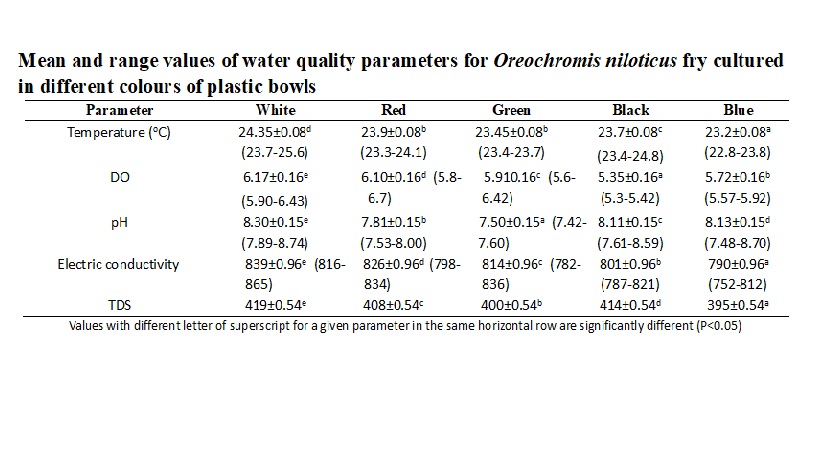COMPARATIVE ASSESSMENT OF GROWTH PERFORMANCE AND SURVIVAL RATE OF Oreochromis niloticus FRY REARED IN DIFFERENT COLOURS OF CULTURE MEDIUM (PLASTIC BOWLS)
DOI :
https://doi.org/10.62050/fjst2025.v9n2.325Mots-clés :
Tilapia, Color, Growth performance, Plastic bowlRésumé
This study was performed to compare the growth and survival rate of Oreochromis niloticus fry in different colours of plastic bowl (50 liters) for 10 weeks. Fry of O. niloticus (mean weight 0.08 g and body length of 0.53 cm) were stocked at 20 fish per bowl (white, red, black, green and blue bowls) in triplicates. They were fed with 45% Crude Protein Coppen feed at 5% body weight. Feeding was done twice daily, between 8 to 9 am and 4 to 5 pm. At harvest, the growth was significantly highest in black bowl but lowest survival of 52.7% (p<0.05). White bowl shows the highest survival rate of 91.3% but the fish camouflaged to the colour of the bowl (albino). Green bowl showed the best condition factor with survival rate of 89.40%. There was significant difference (p<0.05) in mean weight gain (8.62, 8.06, 8.45, 9.37 and 8.44) in white, red, green, black and blue bowls, respectively. The study concluded that the use of plastic bowl in culturing of fry is promising and economical, thereby reducing the cost of pond and tank construction.
##plugins.themes.default.displayStats.downloads##
Références
REFERENCES
Boyd, C. E. (1979). Water quality in warm water fish ponds. Auburn University of Agriculture Experiment Station, Alabama, USA. Page 359.
Boyd, C. E. (1982). Water quality management for pond fish culture/Elsevier scientific publ. Company New York, 318p.
Duncan, D. B. (1995). Multiple range and multiple F-test. Biometrics, 11: 1 – 45.
El-Sayed A.F.M, & Fitzsimmons K. (2024). From Africa to the world—The journey of Nile tilapia. Rev Aquac. 2023; 15(Suppl. 1): 6-21. doi:10.1111/raq.12738
El-Sayed A.F.M. (2017). Fish and fisheries in the Nile Basin. In: AM Negm, ed. The Nile River. Springer International Publishing; 2017: 387-412.
Food and Agriculture Organization (FAO). (2021). Global aquaculture production 1950–2019. http://www.fao.org/fishery/statistics/global-aquaculture-production/query/en. 2021.
Froese, R. & Pauly, D. (2017) Fish Base. World Wide Web Electronic Publication. www.fishbase.org.
Hankins, J. A., Summarfelt, S. T., & Durrant, M. D. (1995). Impacts of feeding and stock management strategies upon fish production within water recycle systems. In: Timmons, M. B. (Ed.). Aquaculture engineering and waste management: Northeast Regional Agriculture Engineering Service: Ithaca, New York, pp. 70 – 89.
McAndrew B.J. Evolution, phylogenetic relationships and biogeography. In: MCM Beveridge, BJ McAndrew, eds. Tilapias: Biology and Exploitation. Kluwer Academic Publishers; 2000: 1-32.
Megbowon, I. & Mojekwu, T. O. (2014). Tilapia sex reversal using methyl testosterone (MT) and its effect on fish, man and environment. biotechnology, 13: 213 – 216.
Megbowon, I. (2011). Tilapia. Tilapia production in Nigeria. Vol. 4, Fisheries Society of Nigeria Quarterly Publication, Nigeria, pp. 18 – 22.
Megbowon, I., Fashina-Bombata, H. A., Mojekwu, T. O. & Okuade, O. A. (2009). Genetic improvement of tilapia challenges and prospects in Nigeria, Niger. J. Fish., 6: 21 – 30.
Olukunle, O. (2013). The growth performance and survival of Clarias gariepinus fry raised in homestead concrete tanks. Journal of Fisheries and Aquatic Science, 8: 243 – 247.
Philippart J.C. & Ruwet J.C. (1982). Ecology and distribution of tilapias. In: Pullin RSV, Lowe McConnell, RH, eds. The Biology and Culture of Tilapias. ICLARM Conference Proceedings No. 7; 1982: 15-59.
Ross, R. M., & Water, B. J. (1995). Importance of rearing-unit design and stocking density on the behaviours growth and metabolism of lake trout (Salvelinus namaysuch). Aquaculture engineering, pp. 40 – 45.
Viveen, W. A. R., Richter, C. J. J., van Oordt, P. G. W. J., Janssen, J. A. L., & Huisman, E. A. (1985). Practical manual for the culture of the African catfish (Clarias gariepinus).
Wahua, T. A. T. (1999). Applied statistics for scientific studies. Afrika-Link Press, 356p.









